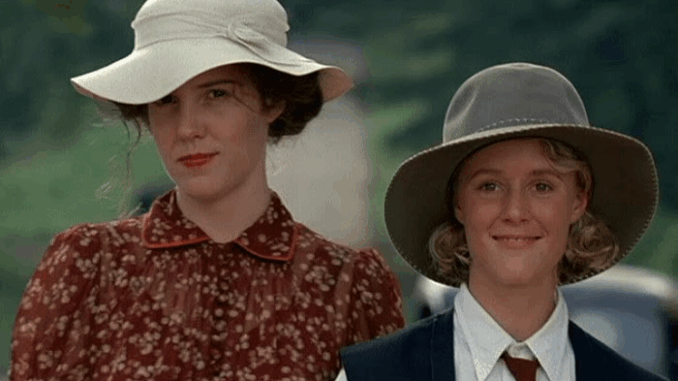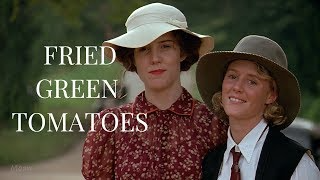
A Scene That Stings and Heals
In a film filled with unforgettable moments, few are as daring, vivid, and symbolic as the beehive scene—when Idgie Threadgoode, portrayed by Mary Stuart Masterson, fearlessly reaches into a wild beehive to retrieve honey. She emerges unscathed, grinning, and hands the dripping comb to Ruth Jamison like it’s a love letter.
On the surface, the scene is whimsical—a moment of Southern folklore come to life. But underneath, it’s one of the most revealing and emotionally charged moments in the entire film. It captures the wild heart of Idgie, her deep (and unspoken) affection for Ruth, and her refusal to live by society’s rules. The bees become symbols of danger and defiance. The honey becomes a sacrament.
Let us explore why this short, powerful scene resonates so deeply with audiences and what it tells us about courage, love, and the sweetness that sometimes comes only through pain.
The Setup: A Tale Within a Tale
The scene is framed as a story told by Ninny Threadgoode (Jessica Tandy) to Evelyn Couch (Kathy Bates), part of the running narrative structure where the past is revealed in fragments. Ninny, as always, tells her stories with color and pride. She’s trying to help Evelyn understand that bravery isn’t always loud or conventional.
As she describes how Idgie once “marched herself right out into the woods” and pulled honey out of a beehive, we cut to the visual—a sun-drenched field, Idgie barefoot and laughing, surrounded by buzzing bees.
The music swells gently. The bees swirl like a halo around her. It feels almost mythic, like we are watching a Southern goddess in her natural element.
Idgie’s Wildness on Full Display
This scene is one of the first major glimpses we get of Idgie as a grown woman—and it immediately tells us everything about her. She’s fearless. She’s connected to nature. She lives by instinct, not rules. And she would do anything to impress or care for Ruth.
Her comfort among the bees is more than a party trick—it’s a metaphor for how she lives. Idgie doesn’t fear pain. She walks right into situations that would terrify most people. But because she trusts the world in her own strange way, the world often responds in kind. She’s stung in other parts of life—by grief, loss, injustice—but in this moment, the bees respect her wild spirit.
Mary Stuart Masterson plays the scene with boundless energy and quiet conviction. There’s no hesitation in her movements, no panic in her breath. She moves with certainty, even reverence. The honey she brings back is not just food—it’s a gift of love, hard-won and freely given.
Ruth’s Reaction: Awed, Touched, Conflicted

While Idgie basks in the joy of the moment, Ruth (played with beautiful restraint by Mary-Louise Parker) is stunned. Her expression is a mix of awe, affection, and something like grief. She is moved—clearly—but also conflicted.
Ruth has been raised to follow rules, to behave, to fit a mold. But here is Idgie, offering her something wild and sweet and impossibly free. It’s tempting—but dangerous.
The honeycomb is handed to Ruth like a symbolic proposal, wordless but powerful. Idgie isn’t just saying “I care about you.” She’s saying, “Look what I’ll go through for you.” And Ruth, torn between fear and desire, accepts it—but can’t yet accept what it means.
In that moment, we understand everything about their dynamic: Idgie gives. Ruth receives. But the emotional current between them is mutual, intense, and unresolved.
The Bees as Symbols of Danger and Identity
Bees are creatures of both order and chaos. They are hyper-organized, loyal, and essential to life—but they are also feared. They sting. They swarm. They defend their queen to the death.
Idgie is much the same. She doesn’t conform to society’s roles, but she lives by her own moral code—one of fierce loyalty, self-sacrifice, and freedom. The bees recognize her as one of their own. She doesn’t invade their space out of greed, but with respect. And because of that, they let her pass unharmed.
The lack of stings isn’t just miraculous—it’s symbolic. Idgie’s authenticity protects her. The world wounds those who pretend, but it sometimes grants grace to those who live truthfully.
Honey as a Symbol of Love and Healing
Honey has long been a symbol in literature and folklore. It represents sweetness, seduction, nourishment, and preservation. In ancient rituals, it was used to anoint, to bury the dead, to treat wounds, and to bless marriages.
So when Idgie offers Ruth the honeycomb, it’s more than a gesture—it’s a sacrament of connection. It’s not a bouquet or a ring, but it carries the same weight. It’s messy, sticky, and real—just like love, just like life.
The fact that the honey was earned, not bought, also reflects Idgie’s character. She doesn’t offer what’s easy. She offers what’s raw and real and requires courage to receive.
Storytelling as a Mirror for Evelyn
In the present-day storyline, Evelyn is being slowly transformed by Ninny’s stories. She watches the beehive scene unfold like a parable. She is beginning to understand that fear isn’t the same as safety, and that sometimes, if you want something sweet, you have to risk the sting.
The image of Idgie with bees becomes a metaphor for Evelyn’s awakening. She begins to ask herself: What hive am I afraid of? What would happen if I dared to reach into the wild and take what I need?
That’s the genius of the storytelling frame in the film: what seems like an old woman’s anecdote is actually a roadmap to liberation.
Cinematic Brilliance in a Quiet Scene
Director Jon Avnet stages the scene with a lyrical touch. There’s a golden glow to the light, a gentle hum to the soundscape, and a reverence to the camera’s gaze. It doesn’t rush. It lets us feel the quiet magic.
The bees are real. The risk is real. But so is the transformation. This is not a special-effects-driven set piece. It’s a moment of truth, beauty, and raw symbolism—and it leaves an imprint on everyone who sees it.
Conclusion: The Sweetness of Risk
The beehive scene in Fried Green Tomatoes is one of the film’s most elegant metaphors. It shows us that love is wild, that bravery isn’t always loud, and that sometimes, the most meaningful gifts come from facing what scares us.
Idgie doesn’t need permission to live fully. She doesn’t ask for approval. She offers honey—not as a prize, but as proof: “This is who I am. Will you accept it?”
And in doing so, she teaches not just Ruth, but Evelyn—and all of us—that the things we most long for may lie beyond fear, surrounded by risk, but waiting—sweet and golden—for the moment we dare to reach out.
